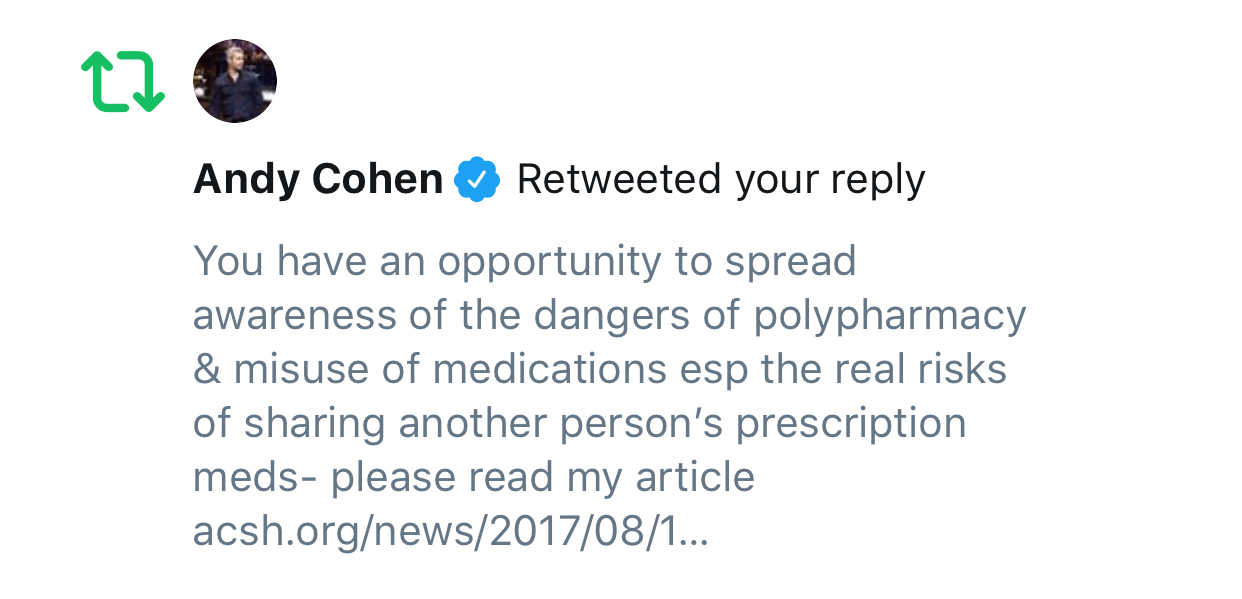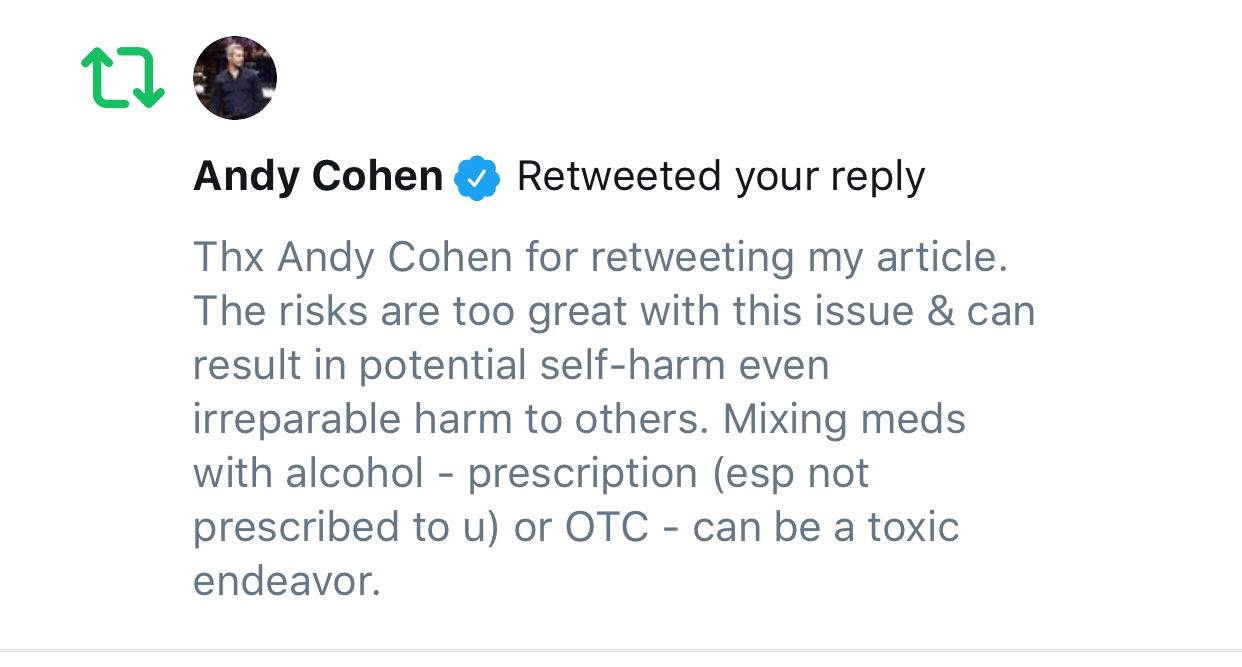Recently, while watching television, I came across a cast reunion show for the reality series Real Housewives of Orange County (RHOC) on the Bravo network. The program cut to a scene where a main character called for an ambulance believing she was having a heart attack. Next, the cast revealed while laughing that she had taken another person’s prescription Adderall in addition to Xanax, alcohol and NyQuil.
This is not the first demonstration of misuse of medications and polypharmacy in the successful franchise (1). Or, on television in general. But, due to Andy Cohen’s -- the program’s host and producer-- apparent support when I engaged him on social media, I am asking him to help further in the interest of public safety.
Thankfully, he re-tweeted my important public health messages regarding the episode:


I think we are at a wonderful moment when Mr. Cohen can utilize his platform to facilitate a much needed conversation, in general, on the hazards of sharing prescriptions, self-medicating and mixing multiple drugs albeit prescription or over-the-counter (OTC) with alcohol and other substances. I respectfully request he include a powerful disclaimer in this and similar programming so there is no confusion over the risks and the public is well-informed.
Happy to help with the content and in any way.
These and other shows on any number of networks get played and replayed. Without such a formal statement, they will disseminate poor messages that if repeated can imperil an individual and others in their path. (See Polypharmacy Problems Go Beyond Tiger Woods). It is a great chance to clarify misunderstandings.
Many preconceptions exist that substances must be illicit in nature to cause problems. Whether legally prescribed, OTC or illegally obtained, certain medicines or drugs whether used properly or abused can impair a person. The combinations, dosages, ingredients, underlying medical conditions present, size of the person and frequency of personal exposures matter. As do individual tolerance and short- and long-term duration history.(2)
According to the National Vital Statistics Reports put out by the U.S. Department of Health and Human Services’ Centers for Disease Control and Prevention (CDC):
-
The number of drug overdose deaths per year increased 23% from 38,329 in 2010 to 47,055 in 2014.
-
During this time period, the percentage of drug overdose deaths involving at least one specific drug increased, from 67% in 2010 to 78% in 2014.
-
Among drug overdose deaths with at least one drug specified on the death certificate, the 10 drugs most frequently involved in overdose deaths included the following opioids: heroin, oxycodone, methadone, morphine, hydrocodone, and fentanyl; the following benzodiazepines: alprazolam and diazepam; and the following stimulants: cocaine and methamphetamine…
-
In 2014, of the 36,667 drug overdose deaths involving at least one specific drug, 52% of these deaths specified one drug, 38% specified two or three drugs, and 11% specified four or more drugs.
Bottom Line: Multiple drug use contributes to many overdose deaths. When self-medication is in the mix, there is a false sense of security individuals have that they truly understand their body’s limits. The statistics I listed don’t support this narrative and are also an underestimation since I did not include all of the near-death experiences to deleterious events that warranted emergency medical treatment and hospitalization.
Note(s):
(1) Polypharmacy used to be a term that emphasized the importance of safe drug usage in elderly patients, especially, who had a tendency of being on four or five (or more) medications for various health conditions. When treating multiple disease states, it is essential for medical personnel to appreciate and avoid the risks of multi-drug interactions. These are taken into account in treating patients and require continuous close monitoring to ensure untoward effects of the drugs themselves don’t take place—even when properly administered— as well as drug-disease and drug-drug adverse events. Other common names for polydrug use include multiple drug intake or combined drug intoxication.
Now, the term has morphed in its meaning to also include more recreational use, often abuse, of prescription to street drugs. Basically, polypharmacy tends to include those using multiple drugs—some define as four, others five or more but these become mere semantics in the more broad discussion.
(2) Self-medicating is a rampant societal issue. There are many, often complex, reasons for it. Some self-medicate for underlying mental illness, diagnosed or not (e.g. depression, anxiety). Others battling addiction who may or may not have associated physical or mental health problems. Some with chronic pain. And so on.




